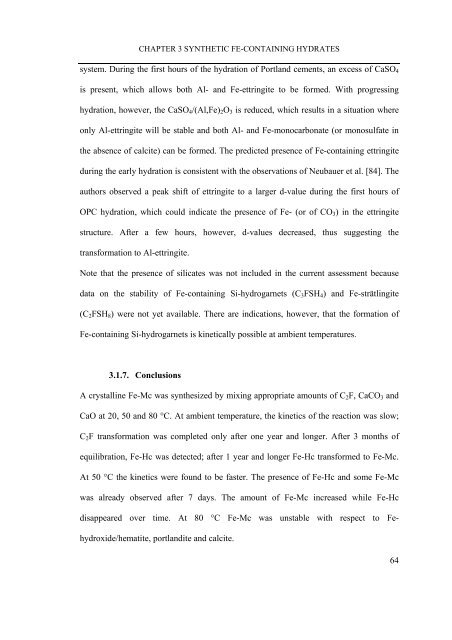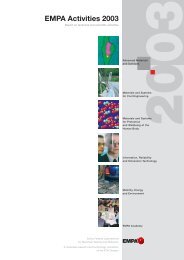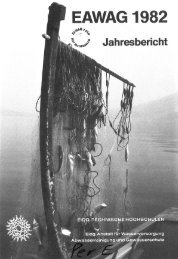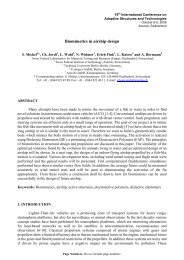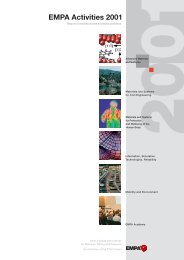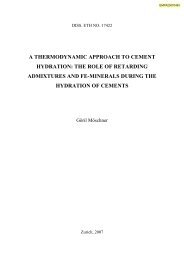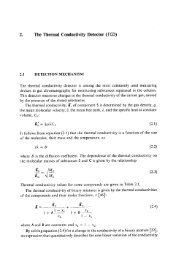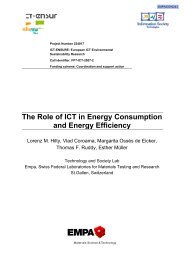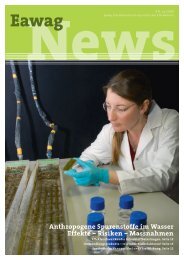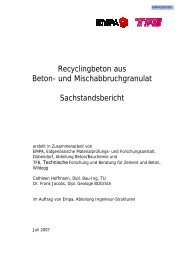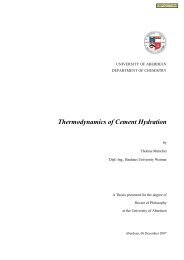Belay Zeleke Dilnesa - Eawag-Empa Library
Belay Zeleke Dilnesa - Eawag-Empa Library
Belay Zeleke Dilnesa - Eawag-Empa Library
You also want an ePaper? Increase the reach of your titles
YUMPU automatically turns print PDFs into web optimized ePapers that Google loves.
CHAPTER 3 SYNTHETIC FE-CONTAINING HYDRATES<br />
system. During the first hours of the hydration of Portland cements, an excess of CaSO4<br />
is present, which allows both Al- and Fe-ettringite to be formed. With progressing<br />
hydration, however, the CaSO4/(Al,Fe)2O3 is reduced, which results in a situation where<br />
only Al-ettringite will be stable and both Al- and Fe-monocarbonate (or monosulfate in<br />
the absence of calcite) can be formed. The predicted presence of Fe-containing ettringite<br />
during the early hydration is consistent with the observations of Neubauer et al. [84]. The<br />
authors observed a peak shift of ettringite to a larger d-value during the first hours of<br />
OPC hydration, which could indicate the presence of Fe- (or of CO3) in the ettringite<br />
structure. After a few hours, however, d-values decreased, thus suggesting the<br />
transformation to Al-ettringite.<br />
Note that the presence of silicates was not included in the current assessment because<br />
data on the stability of Fe-containing Si-hydrogarnets (C3FSH4) and Fe-strätlingite<br />
(C2FSH8) were not yet available. There are indications, however, that the formation of<br />
Fe-containing Si-hydrogarnets is kinetically possible at ambient temperatures.<br />
3.1.7. Conclusions<br />
A crystalline Fe-Mc was synthesized by mixing appropriate amounts of C2F, CaCO3 and<br />
CaO at 20, 50 and 80 °C. At ambient temperature, the kinetics of the reaction was slow;<br />
C2F transformation was completed only after one year and longer. After 3 months of<br />
equilibration, Fe-Hc was detected; after 1 year and longer Fe-Hc transformed to Fe-Mc.<br />
At 50 °C the kinetics were found to be faster. The presence of Fe-Hc and some Fe-Mc<br />
was already observed after 7 days. The amount of Fe-Mc increased while Fe-Hc<br />
disappeared over time. At 80 °C Fe-Mc was unstable with respect to Fe-<br />
hydroxide/hematite, portlandite and calcite.<br />
64


